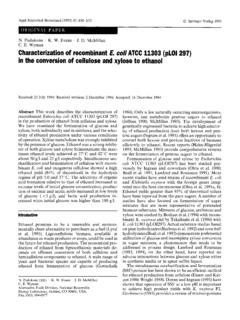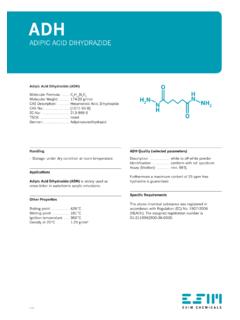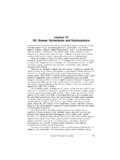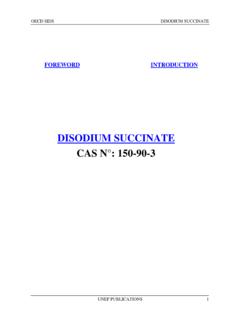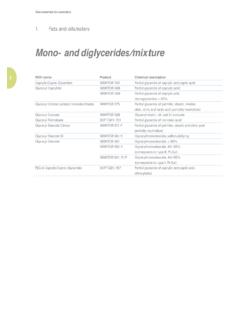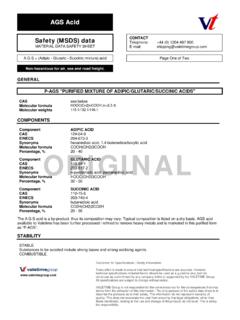Transcription of Research Paper Preparation of Novel Monoesters …
1 M. Iqbal et al / Chemistry Journal (2012), Vol. 02, Issue 02, pp. 87-94 ISSN 2049-954X. Research Paper Preparation of Novel Monoesters of succinic Acid from succinic Anhydride using p-Toluensulphonic Acid as a Catalyst Muhammad Iqbal, Imam Bakhsh Baloch and Musa Kaleem Baloch*. Department of Chemistry, Gomal University, Dera Ismail Khan, KPK, Pakistan Phone: +92-966-750424-429; Fax: +92-966-750255. *E-Mail: Abstract The industrial and pharmaceutical applications of Monoesters of succinic anhydride have always prompted the scientists for exploring new methods for the synthesis of the products without using toxic and expensive chemicals. However, up to now no significant approach has come forward.
2 The available methods are not only ecologically unfriendly create heat, evolve toxic gases but also provide low yield. Therefore, a new technique has been proposed in which the opening of ring of succinic anhydride was performed by treating it with aryl alcohols, using p-toluenesulphonic acid as a catalyst and toluene as a solvent. In this way 1-27 Monoesters of di-, and tri-substituted aryl alcohols have been synthesised with good yield; however, in case of 2,6-disubstituted alcohols the yield was considerably lower than others and was attributed to steric hindrance. The final products were purified using chromatographic techniques and their structure was confirmed by recording IR, UV, 1D, 2D, (1H- and 13C-) NMR spectra, mass measurements and elemental analysis.
3 Keywords: succinic Anhydride, Aryl Alcohols, Monoesters of succinic Acid, 1D-NMR, 2D-NMR of Monoesters 1. Introduction The mono-alkyl or mono-aryl esters of succinic are However, they require huge amount of strong inorganic valuable synthons for several industrial, agrochemical and acids, carcinogenic transition metal hydrides and / or their pharmaceutical targets (Kashima et al, 2001; Nardello et complexes and hence face serious concerns from green al, 2006; Marchal et al, 2008; Wang et al, 2009 and Zhang chemistry. The huge disposal of waste product is a real et al, 2010). These are also used as starting material in the threat to our ecological system and aquatic life (Matsumu- synthesis of several bio-active compounds like alkaloids, ra et al, 1998 and Ostermeier et al, 2003).
4 The production flavonoids, glycosides, terpenoids, vitamins, -tocopherol, of heat and gases during the reactions results global warm- vitamin K1, polymers and other valuable and daily used ing and hence create pollution (Luman et al, 2004 and products (Jiang et al, 2007 and Hekking et al, 2008). These Maeda et al, 2005). Use of expensive materials, multi-step compounds have also been used as resolving agents Preparation , use of protecting groups to mask the active (Maeda et al, 1997). It has been reported that their derivati- sites and their recovery make the techniques uneconomical ves with naturally occurring biologically active compound- formation of side products results low yield of final ds showed enhancement of their activities used against product (Matsumura et al, 1998; Ostermeier et al, 2003.)
5 HIV, bacteria and fungi (Cava et al, 1965; Chang et al, Luman et al, 2004 and Maeda et al, 2005). Recently, we 1991; Fujimaki, 1998; Basak et al, 1999; Matsumura et al, reported the synthesis and structural characterization of 2000 and Vraka et al, 2006). Keeping in view all these Novel Monoesters of succinic anhydride with aryl alcohols facts, various synthetic techniques have been explored. using two-step synthesis from low-cost substrates and Available online at 87. M. Iqbal et al / Chemistry Journal (2012), Vol. 02, Issue 02, pp. 87-94 ISSN 2049-954X. solvents (Iqbal et al, 2012). Following the same technique, digital melting point apparatus and are uncorrected.
6 The we have synthesized twenty seven (1-27) new Monoesters UV spectra were recorded in absolute MeOH employing of succinic acid by reacting succinic anhydride with di-, IRMECO UV/VIS Model U-2020 spectrophotometer. IR. and tri-substituted aryl alcohols using toluene as a solvent spectra were obtained on a TENSOR 27 FT-IR spectroph- and p-toluenesulphonic acid as a catalyst (Scheme 1) and otometer supplied by Bruker, Ettiligen, Germany. 1H- established their structure with the help of modern (2D- NMR and 13C-NMR (1D-, 2D-NMR) spectra were procur- NMR) spectroscopic techniques (Table 1). ed in CDCl3 at (1H) 300 MHz, (13C) 75 MHz using Bruker Scheme 1.
7 Preparation of Monoesters 1-27. Table 1. Prepared Monoesters 1-27 and Reaction Time Compound Ar Time (Hrs) Compound Ar Time (Hrs). 1 2,4(Cl2)C6H3 14 15 3,5(NO2)2C6H3 17. 2 2,5(Cl2)C6H3 14 16 2,6(EtO)2C6H3 14. 3 2,6(Cl2)C6H3 14 17 3,4(EtO)2C6H3 14. 4 3,4(Cl2)C6H3 14 18 3,5(HO)2C6H3 13. 5 3,5(Cl2)C6H3 14 19 2,3,4(MeO)3C6H2 14. 6 2,3(F2)C6H3 16 20 2,4,5(MeO)3C6H2 14. 7 2,4(F2)C6H3 16 21 3,4,5(MeO)3C6H2 14. 8 2,5(F2)C6H3 16 22 3-MeO-4-NO2-C6H3 15. 9 2,6(F2)C6H3 16 23 4-MeO-3-NO2-C6H3 15. 10 2,4(Me2)C6H3 15 24 2-MeO-5-NO2-C6H3 15. 11 2,5(Me2)C6H3 15 25 2,4,6(Cl)3C6H2 17. 12 3,4(Me2)C6H3 15 26 2,4,5(Br)3C6H2 17. 13 3,5(Me2)C6H3 15 27 2,4,6(Me3)C6H2 17.
8 14 3,4(NO2)2C6H3 17 - - - 2. Experimental Biospin, AMX 300 MHz FT NMR spectrometer; trimethy- lsilane (TMS) was used as an internal reference. Column Physical Measurements chromatography was carried out using silica gel (PF254, mesh size 60-70), E. Merck, Darmstadt, Germany; analyt- All the required chemicals (aryl alcohols, anhydride, p- ical and preparative thin layer chromatography was perfor- toluenesulphonic acid anhydrous, toluene, hexane, benze- med on pre-coated silica gel plate (20 20 cm, mm ne, methanol, ethanol, ethyl acetate, diethyl ether, chlorof- thickness) with UV fluorescence indicator (PF254), E. orm, sodium sulphate and sodium bicarbonate) were purc- Merck, Darmstadt, Germany, using n-hexane-ethylacetate hased from Sigma-Aldrich, St.
9 Louis, New York, USA. All mixture. the reagents were of analytical grade and used as such, except toluene. The toluene was dried and then stored over General Procedure for the Preparation of Monoeste- sodium metal before use. The purity of alcohols and succi- rs 1-27. nic anhydride was checked by taking IR and NMR spectra. The melting points were determined using Gallenkamp Twenty (1-27) aryl succinic acids were synthesized by Available online at 88. M. Iqbal et al / Chemistry Journal (2012), Vol. 02, Issue 02, pp. 87-94 ISSN 2049-954X. adding 20 mmol of corresponding alcohol into a single- is calculated for C11H10Cl2O4 ( ): C, ; H, necked round-bottom flask (100 mL), already containing %, Cl ; Found: C, ; H, , Cl, succinic anhydride (20 mmol), anhydrous p-toluenesulfon- ic acid ( mmol) and toluene (20 mL) under nitrogen 2,6-dichlorobenzyl hydrogen succinate (3): Yield 58%, atmosphere.
10 The apparatus was equipped with magnetic g ( mmol). Colourless, amorphous solid, 77- stirrer, Dean Stark trap and a reflux condenser. The mixtu- 79 C; UV (EtOH) max nm (log ): 258 ( ). 1H-NMR. re was refluxed for variable times (Table 1) and allowed to (300 MHz, CDCl3): H (ppm): (t, J= Hz, 2H, cool up to 25 C. After cooling, it was poured into saturat- CH2CO), (t, J= Hz, 2H, CH2CO), (s, 2H, ed aqueous NaHCO3 solution ( mL) and the organic OCH2), (m, 3H, Ar-H), (br, s, 1H, layer was extracted with hexane (3 25 mL). The organic exchangeable with D2O, OH). 13C-NMR (75 MHz, CDCl3. phase was then washed with brine (10 mL), dried over multiplicity in DEPT): C (ppm): (t, CH2CO), (t, anhydrous Na2SO4 and the excess of the solvent was remo- CH2CO), (s, CO), (s, CO), (t, CH2O), ved under vacuum to give a resinous products.

